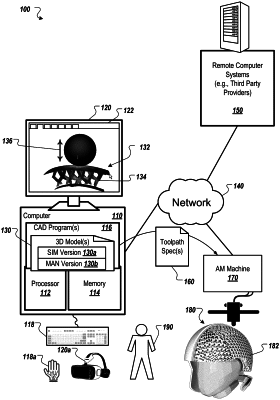| CPC G05B 19/4099 (2013.01) [G06F 30/10 (2020.01); G06F 30/20 (2020.01); G05B 2219/34279 (2013.01); G05B 2219/35134 (2013.01); G06F 2111/10 (2020.01); G06F 2113/10 (2020.01)] | 27 Claims |

|
1. A method comprising:
obtaining a skeleton model of a lattice structure to be included in a three dimensional model of a physical object to be manufactured, the skeleton model comprising nodes and lines representing beams of the lattice structure;
constructing a control point frame surface model of the lattice structure using the skeleton model;
generating a shell mesh model of the lattice structure using the control point frame surface model, wherein the shell mesh model corresponds to hollow versions of the beams of the lattice structure;
performing dynamic numerical simulation of the physical object, using the shell mesh model included within the three dimensional model of the physical object, to produce a current numerical assessment;
modifying the skeleton model or the control point frame surface model based on the current numerical assessment to change the lattice structure;
repeating the constructing, the generating and the performing, or the generating and the performing, one or more times until the numerical simulation indicates the lattice structure satisfies at least one impact response requirement for the physical object;
producing from the control point frame surface model a solid body model of the lattice structure in which the beams are hollow; and
providing at least the solid body model for use in manufacturing a hollow lattice structure, which corresponds to the solid body model, for the physical object using one or more computer-controlled manufacturing systems.
|